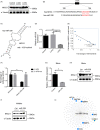Bioinformatics analysis of differentially expressed miRNAs in non-small cell lung cancer
- PMID: 32965722
- PMCID: PMC7891510
- DOI: 10.1002/jcla.23588
Bioinformatics analysis of differentially expressed miRNAs in non-small cell lung cancer
Abstract
Objective: Non-small cell lung cancer (NSCLC) contains 85% of lung cancer. Lung adenocarcinoma (LUAD) and lung squamous cell carcinoma (LUSC) are the largest NSCLC subgroups. The aim of the study was to investigate the underlying mechanism in developing more effective subtype-specific molecular therapeutic procedures.
Methods: A total of 876 specimens were used in this study: 494 LUAD tissues (ie, 449 LUAD tissues and 45 matched normal tissues) and 382 LUSC tissues (ie, 337 LUSC tissues and 45 matched normal tissues). The miRNA sequencing data were processed using R. The differential expressed miRNAs between lung cancer and normal tissues were analyzed using the limma package in R. Gene expression, Western blotting, hematoxylin and eosin staining, and luciferase assay were used to test LUAD and LUSC.
Results: LUAD and LUSC appear sharply distinct at molecular and pathological level. Let-7a-5p, miR-338, miR-375, miR-217, miR-627, miR-140, miR-147b, miR-138-2, miR-584, and miR-197 are top 10 relevant miRNAs and CLDN3, DSG3, KRT17, TMEM125, KRT5, NKX2-1, KRT7, ABCC5, KRAS, and PLCG2 are top 10 relevant genes in NSCLC. At the same time, the miRNAs expression levels were also quite different between the two groups. Among the differential expressed miRNAs, let-7a-5p was significantly down-regulated in LUAD while miR-338 was markedly down-regulated in LUSC. Bioinformatics analyses appeared that let-7a-5p directly targets high-molecular weight keratin 5 (KRT5) which were shown to be a strong risk factor for LUAD. And NK2 homeobox 1(NKX2-1) which was associated with tumor progression in LUSC was identified as a target gene of miR-338.
Conclusions: Distinct profile of miRNAs can take a part in the development of LUAD and LUSC and thus could serve as a subtype-specific molecular therapeutic target to protect against LUAD and LUSC.
Keywords: biomarker; lung adenocarcinoma; lung squamous cell carcinoma; miRNAs; non-small cell lung cancer.
© 2020 The Authors. Journal of Clinical Laboratory Analysis Published by Wiley Periodicals LLC.
Figures




Similar articles
-
Downregulation of HOXA3 in lung adenocarcinoma and its relevant molecular mechanism analysed by RT-qPCR, TCGA and in silico analysis.Int J Oncol. 2018 Oct;53(4):1557-1579. doi: 10.3892/ijo.2018.4508. Epub 2018 Jul 30. Int J Oncol. 2018. PMID: 30066858 Free PMC article.
-
MiRNA expression profiling in adenocarcinoma and squamous cell lung carcinoma reveals both common and specific deregulated microRNAs.Medicine (Baltimore). 2022 Aug 19;101(33):e30027. doi: 10.1097/MD.0000000000030027. Medicine (Baltimore). 2022. PMID: 35984198 Free PMC article.
-
Deciphering molecular overlaps between COPD and NSCLC subtypes (LUAD and LUSC): An integrative bioinformatics study.Medicine (Baltimore). 2025 Aug 15;104(33):e43906. doi: 10.1097/MD.0000000000043906. Medicine (Baltimore). 2025. PMID: 40826767 Free PMC article.
-
The Effect of GLUT1 on the Survival Rate and Immune Cell Infiltration of Lung Adenocarcinoma and Squamous Cell Carcinoma: A Meta and Bioinformatics Analysis.Anticancer Agents Med Chem. 2022;22(2):223-238. doi: 10.2174/1871520621666210708115406. Anticancer Agents Med Chem. 2022. PMID: 34238200 Review.
-
MicroRNA‑mediated regulation in lung adenocarcinoma: Signaling pathways and potential therapeutic implications (Review).Oncol Rep. 2023 Dec;50(6):211. doi: 10.3892/or.2023.8648. Epub 2023 Oct 20. Oncol Rep. 2023. PMID: 37859595 Free PMC article. Review.
Cited by
-
Hyaluronic acid-modified milk exosomes carrying ZNF516 inhibit ABCC5 and contribute to pemetrexed sensitivity in lung adenocarcinoma.Hum Cell. 2025 Apr 19;38(3):92. doi: 10.1007/s13577-025-01219-6. Hum Cell. 2025. PMID: 40253507
-
LncRNA CERS6-AS1 promotes proliferation and metastasis through the upregulation of YWHAG and activation of ERK signaling in pancreatic cancer.Cell Death Dis. 2021 Jun 24;12(7):648. doi: 10.1038/s41419-021-03921-3. Cell Death Dis. 2021. PMID: 34168120 Free PMC article.
-
Six-Gene Signature for Differential Diagnosis and Therapeutic Decisions in Non-Small-Cell Lung Cancer-A Validation Study.Int J Mol Sci. 2024 Mar 23;25(7):3607. doi: 10.3390/ijms25073607. Int J Mol Sci. 2024. PMID: 38612418 Free PMC article.
-
Identification of EGFR-Related LINC00460/mir-338-3p/MCM4 Regulatory Axis as Diagnostic and Prognostic Biomarker of Lung Adenocarcinoma Based on Comprehensive Bioinformatics Analysis and Experimental Validation.Cancers (Basel). 2022 Oct 17;14(20):5073. doi: 10.3390/cancers14205073. Cancers (Basel). 2022. PMID: 36291859 Free PMC article.
-
An 11-Gene Signature Risk-Prediction Model Based on Prognosis-Related miRNAs and Their Target Genes in Lung Adenocarcinoma.Front Oncol. 2021 Nov 5;11:726742. doi: 10.3389/fonc.2021.726742. eCollection 2021. Front Oncol. 2021. PMID: 34804921 Free PMC article.
References
-
- Torre LA, Bray F, Siegel RL, Ferlay J, Lortet‐Tieulent J, Jemal A. Global cancer statistics, 2012. CA Cancer J Clin. 2015;65(2):87‐108. - PubMed
-
- Jemal A, Siegel R, Xu J, Ward E. Cancer statistics, 2010. CA Cancer J Clin. 2010;60(5):277‐300. - PubMed
-
- Lewis BP, Burge CB, Bartel DP. Conserved seed pairing, often flanked by adenosines, indicates that thousands of human genes are microRNA targets. Cell. 2005;120(1):15‐20. - PubMed
MeSH terms
Substances
LinkOut - more resources
Full Text Sources
Medical
Research Materials
Miscellaneous

